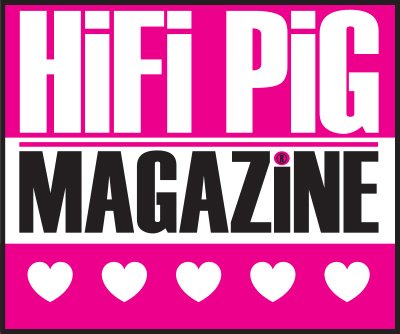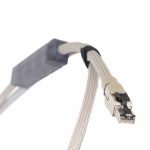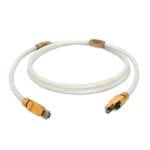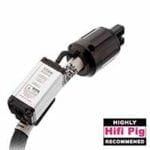WITCH HAT AUDIO MORGANA CABLES FOR NAIM REVIEW
Dan Worth tries out a range of cables aimed specifically at users of Naim electronics.

Witch Hat Audio Cables are beautifully presented and specific to Naim audio equipment.
Becoming fussy with cables can take you down the proverbial rabbit hole. Becoming fussy with cables for Naim equipment becomes another adventure altogether. And this is a quest I’ve recently begun to pursue.
I became intrigued again with Naim equipment after having a Supernait 2 for a little while. I decided on trying both a Hicap and Supercap to boost performance and very swiftly moved onto a 282/250DR pre and power, all using Naim’s own and Teddy Pardo’s cabling. Although better than the Supernait combinations, I found myself becoming more and more critical of the sound as the price point increased. A fairly commonplace to find oneself in as expenditure increases and returns diminish.
Great pace and rhythm has always been one of Naim’s most addictive attributes and the 282/250DR combo did this well, however, the overall sonic signature for me wasn’t quite where I felt it should be at its respective price point, in terms of detail refinement, imaging and overall control. I also felt there to be issues with the top end sounding etched and a trifle hard at times.
Chatting to the guys at Witch Hat Audio who are a team of ex Naim engineers I was gently coerced down the route of an older all Olive system with some key modifications and tweaks to be applied, along with the suggestion that using their Morgana range of cabling would have their own unique and very worthwhile benefits.
Unlike any other cable companies that produce cables for the more standard and wider used connection formats in audio, Witch Hat Audio predominantly concentrate on Naim equipment. With Naim cables, the parameters of capacitance and inductance are much more critical to really get the best from the equipment and although many other cable brands have a Naim variant of cables, high expectancies are placed on Witch Hat to perform at the highest level, being very much specific to the Naim connection interface.
I’ve always championed the benefits of well-constructed cabling and over the years have worked my way through many, from homemade to uber-expensive commercial variants, all with varying degrees of performance and associated attributes.
My brother-in-law who sold Naim for many years confirmed WHA’s sentiments that the older Olive range was indeed some of their very best amplifiers and so I picked up an Olive 102/napsc/250 combo and a 52/52PS with a pair of 135 monoblocks to pass on to Witch Hat for service and to bring them up to date. I requested their ‘Hatpin’ cables in the same configuration as the Naim and Teddy Pardo cables I was currently using and of course to give some sort of comparison to the companies top of the line Morgana range.
APPEARANCE
Witch Hat’s Hatpin cable is nicely packaged in a thick black paper sleeve with sticker branding and appeared well constructed but somewhat standard and in-line with its price point and equivalent Naim cables.
The Morgana range… now that’s another story.
For my system, I required the Morgana SC/52PS Burndy cable to go between 52 and 52PS. A pair of Morgana XLR Mono cables to go between the 52PS and 135s. The Morgana XLR Stereo to run between the 102 and 250 and a Morgana Source RCA for input from my DAC to either of the amplifier setups.
The presentation of the Morgana cable is pretty impressive, to say the least! A gold foil branded outer white box is first opened to reveal a large ‘jewellery’ type case, which when opened is lined with white leather, again sporting the company’s branding on the inside of the lid in gold foil.
The cables themselves look and feel great with a softer cotton-rich braid rather than the more commonly used nylon and with a black and silver diamond design. The custom DIN plugs have a Witch Hat Audio emblem 3D printed on their outer bodies. All RCA or XLR plugs are KLE pure copper silver-plated ‘Kryo’ plugs. The overall presentation, look and feel of a Morgana is very generous considering their price tags. As first impressions go, this is a good start.
CONSTRUCTION
As I mentioned previously when building cables for Naim equipment especially, the parameters need to measure very accurately. For many years Naim has been pushed towards creating a range of cables that exceed the performance of their standard cabling included with their products, previously leaving this to third party companies to capitalise on what Naim only recently have done for themselves.
Inside a Witch Hat Morgana cable there is a mixture of very high purity copper cables from selected sources encapsulated in a proprietary dielectric shielded in an array of braids and foils to protect the signal conductors from airborne nasties such as RFI and EMI as well as controlling capacitance and inductance.
Configuration is dependent on which form of Morgana cable you select and specific to the connection type you require, with each cable being constructed to best suit the electrical parameters of the output and input stages of each specific piece of equipment. Their SC/52PS Burndy cable is constructed in two separate lines, dealing with power and the delicate audio signal individually and terminated into the same plug at each end with directional splitters partway along the cable to show orientation when installing.

The cable finish is comensurate with their presentation.
BURNING IN
First of all, we need to approach the subject of burn-in. One that many people are unaware of or simply don’t appreciate. Any cable, in my opinion, needs a good month or so to really sound as it should with the initial two weeks being a bit of a roller coaster ride. During this period the sound will change dramatically. In my experience perseverance is key during this period and using a Morgana is no exception. My initial first evening using each of the Morganas was pretty good and gave me a rough idea of what to expect from them. I’ve been reviewing, testing and producing cables for so long now I have the ability to gauge potential as well as having that ‘waiting for paint to dry’ patience.
With Morgana I had a very positive initial outlook, finding the performance to be very promising in terms of resolution, imaging and bandwidth. Over the course of two weeks the cable, first of all, became quite harsh sounding for a couple of days, then mellowed but sounded flat in terms of soundstage shaping and dynamics. Progressing through the second week a more balanced and controlled sound was becoming apparent. The treble had smoothed out and presented more sparkle and air which gave me even more enthusiasm in terms of the rest of the frequency range catching up, fleshing out and becoming more robust and rhythmic over the course of another week.
THE SOUND
Using the Morgana XLR Stereo with the ‘New Classic’ amps I found bass lines had more defined slap to a kick drum and a more detailed lower-end extension with double bass and bass guitar. The midrange was less forward and the top-end a little smoother and refined with additional air and sparkle on the 282/250DR combo.
Much the same was reflected in the Olive 102/250 setup, with both presenting a larger soundstage, more insight, better detailing and more believable and naturally exciting dynamics. The New Classics excelled slightly on bass performance, being a little tighter and enthusiastic, and the Olives displayed a slightly more refined and tonally rich treble and lucid midrange. Most importantly though was how both setups retained their ‘Naim Note’ and got a boost in overall performance that was a little more generous than I had expected, polishing the scratches and buffing the edges to bring out their potential.
The 52/52PS and 135 monoblocks, one of Naim’s most sought after combinations of all time, performed admirably with an addictively musical performance with a wide-open soundstage and a flow that carried details and dynamics on a journey that keeps you listening for hours on end. What the Morgana cables offer here is quite special I think.
The Morgana 52PS/SC Burndy cable opens up power reserves that in hindsight seemed to be holding back another level of capability in terms of bass expression, delivering more organic vocal inflections and timbre, which in conjunction with the additional resolution, air and space in the top-end made good recordings sound more lifelike and poor recordings more palatable, which was a nice surprise as generally a cable or piece of equipment which can expose more detail can be detrimental to poorer recordings.
A pair of Morgana XLR Mono interconnects introduced further levels of effortlessness in terms of power and grip. Overall texture from top to bottom was a leap ahead over all the previous cables used and were a good leap ahead of Witch Hat’s own Hatpin cable, proving that the extra expenditure is indeed a worthwhile one. The 135s give a fantastically open soundstage compared to a 250, but with a full Morgana complement of cables, including the analogue stereo pair from my DAC’s phono outputs to the 5 pin input on the 52, pretty much gave them a new lease of life.
Overall, with all the amp combos the tempo of the music became even more toe-tapping and rhythmically stronger due to a more reinforced, stronger and more detailed bass line. I wouldn’t say it was necessarily deeper or more extended. However, it was cleaned up, more accurate and just conveyed so much more information and articulation.
With a speaker as transparent and revealing as my all-ceramic driver Ayons (much like the higher-end Focals in presentation) any nasties can be presented ruthlessly. Previously there wasn’t much I could complain about when it came to the upper end of the frequency response, especially with the New Classics and especially with some female artists, but now there was no cause for complaint at all. Yes, there were instances where I felt I’ve heard other equipment suit my speakers and musical tastes better, this being a system usually running off an all-valve pre and power, but I could clearly discern what the Morgana had brought to the table.
It was also clearly evident that in my system and in my opinion, the Olive amps sounded better than the New Classics in some ways – they were more controlled and delicate in the upper-midrange and treble which I turn opened up the height of the soundstage further with the Morganas in place. The Olives also gave a more natural sound with better sparkle and less splashiness.

A closer look at the Naim specific cable.
HATPIN vs MORGANA
The Hatpin at its very reasonable price at just over £100 is a review in its own right really, but I’ll touch on them in a quick comparison. The cable is a stone-cold bargain for starters in my opinion and for anybody with a more modest Naim setup or wanting a more budget upgrade, it’s a no brainer. They are utterly engaging and do things I didn’t believe possible in this price range. What I like the most about the Hatpin is that until replacing it with something like a Morgana you don’t actually feel like you are missing out on anything.
It’s a great compromise for allowing the traditional ‘Naim Note’ to rock and without taking on a more ‘HiFi’ style of sound signature. Witch Hat are all about retaining that Naim sound and Hatpin with its ability to convey all of Naim’s fun tempo driven attributes really compliments the equipment well.
Morgana in comparison steps up the game. Whilst critically retaining the boogie factor, it manages to release all the inner detail that previously seemed constrained and somewhat veiled, magnifying performance throughout the entire audio spectrum. Every note has an additional layer of clarity with leading edges becoming more defined. Tonally notes seem to last for longer, and during acoustic tracks note decays seem to last forever at times, with no smearing and far more accurate layering, producing a more three-dimensional effect. Bass depth and definition is again perceivably better, Hatpin does a fantastic job with bass lines and it’s only when you get to hear Morgana side by side that the additional expenditure becomes worthwhile – it’s 4 times the price, so should I expect 4 times the performance? No, that’s a crazy analogy to make and one that people often do and in my opinion, it can’t be thought of like that – liken it to a high-performance car on great road tyres, put it on track tyres at say 10 times the cost, it doesn’t mean it’s going to be 10 times better or faster as an overall car, it just means that you are going to extract more of the potential performance of the vehicle itself, much like the cable’s connection with the electronics.

A variety of Naim specific cables are available.
CONCLUSION
As with all cables there are always going to be sceptics, and I’d imagine that there are possibly more sceptics in the Naim camp with regards to cables than other areas of HiFi due to Naim never previously giving any real emphasis on cables – apart from the fact that the ones they produced were fit for purpose. I’d imagine that newer generations of music lovers with a more open mind to cabling, alongside Naim themselves realising the potential of good cabling and producing some fantastic in-house variations, has changed the perception of the previous notion, bringing the older Naim fan-boy around to the possibilities of better performance as well as new generations of enthusiasts alike. This does nothing but aid companies such as Witch Hat Audio and others who have been producing Naim based cabling.
Morgana is a sexy, well dressed and presented cable, produced with great care and attention by those who have long-standing reputations with Naim and possibly a little better understanding of how to retain Naim’s personality of sound than some of the other modification companies on the market. Morgana has an addictive rhythmic flow, which with its carefully and electrically matched construction exploits all of the equipment’s potential.
Morgana has made a huge difference in the three Naim systems I’ve tried it in, from the Classic 90’s Olive 102/250/Supercap and 52/52PS/135s to the modern-day New Classic 282/250DR/Supercap. It has opened up a new window of performance, whilst retaining what makes these amplifiers musically engaging. I can say that although I love my valves, Naim has found a new place in my heart and given a new lease of life to some genres such as Rock, Dance and Pop.
AT A GLANCE
Build Quality:
Packaging is beautiful and far exceeds what generally comes with a cable at this price point
Cable build, plugs and additional custom made splitters etc are all top of the line
Sound Quality:
Engaging, musical, detailed, open and, most importantly, completely respectful of the Naim sound.
Value For Money:
Excellent, you really get pride of ownership factor with Morgana both aurally and visually
A lot of care and attention was put into creating and presenting this cable
We Loved:
The fit and finish of the cable. The expertise in manufacturing. The overall presentation of the product and of course how complimentary to the Naim sound the cable is.
We didn’t love so much:
Nothing to report at the comparative price point
Price:
Morgana Source RCA 1m (stereo) – £450 inc. VAT
Morgana XLR Stereo – £450 inc. VAT
Morgana XLR Mono 1m – £675 inc. VAT
Morgana SC/52PS Burndy 1m – £800 inc. VAT
Elevator Pitch Review: Morgana is a beautiful looking cable that has been specifically designed and constructed to complement Naim electronics. The cables manage both maintain that classic Naim characteristic of speed and rhythm but manage to make it “more so”.

Dan Worth




















































































































































































